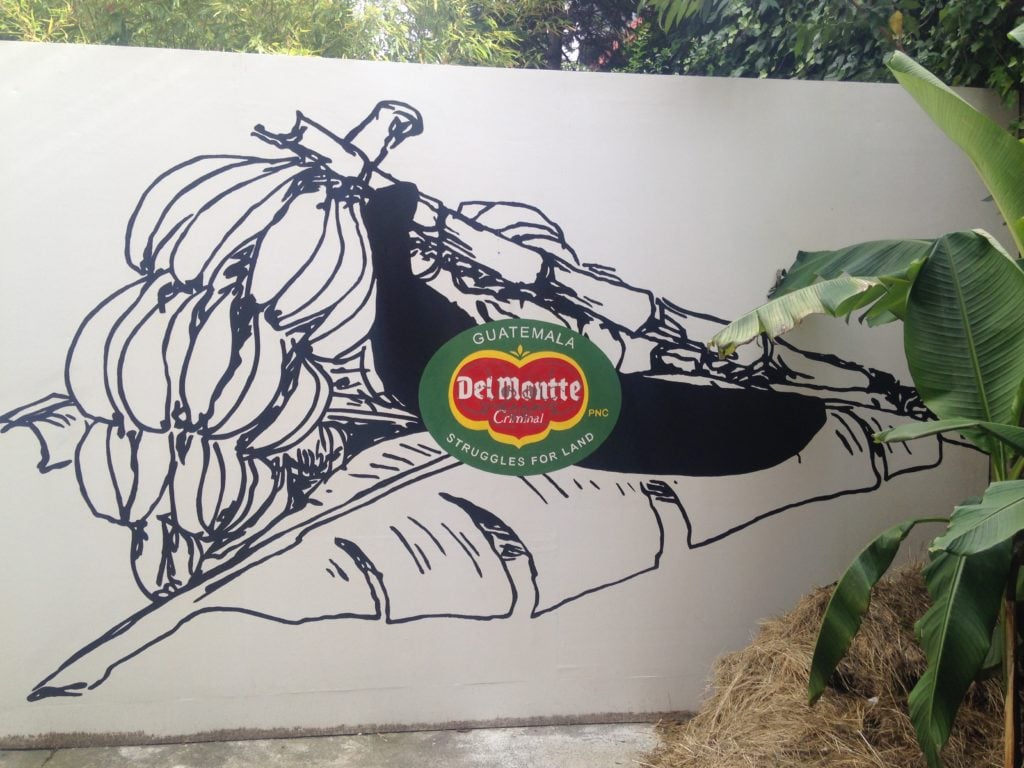Review: Under The Same Sun: Art From Latin America Today @ South London Gallery
July 17, 2016

Minerva Cuevas’s Del Montte-Bananeras
South London Gallery’s Summer exhibition, Under The Same Sun: Art From Latin America Today, poses a diverse and yet somehow streamlined vision of Latin American art from the 1970s to the present. It is staged over several locations in the main gallery and the ex-fire station on opposite sides of the Peckham Road, with an extra piece transforming and breathing colourful life into the floor of a nearby playground. All of this conforms with the overriding concept of the exhibition: that while neither Latin America nor its art should be viewed as a single homogenous entity, it is something which deserves greater recognition, celebration, and scrutiny in the North as well as on this side of the Atlantic.
Perhaps the most striking element of the show is the recurring motif of political dissent and protest. Alfredo Jaar’s A Logo For America is a well-documented animation for a 1987 New York billboard which derides the misconception that ‘America’ comprises of the United States alone. This leads a set of pieces which span the temporal breadth of the exhibition. Among these is Carlos Motta’s Brief History of US Interventions in Latin America Since 1946, a printed and self-explanatory piece, as well as a video entitled Drinking Song, in which the US national anthem is played on a set of bottles.
The slightly twee, amusing aspect to Donna Conlon and Jonathan Harker’s video is underpinned by a more sinister toppling of beer cans to finish, representing the US imperialism towards Panama with its involvement and running of the Panama Canal project from 1914-99. This video piece is one of several in the new Fire Station, and it is accompanied by Minerva Cuevas’ mural, Del Montte-Bananeras. It references the exploitation of natural resources as well as the Guatemalan President Montt, responsible for the genocide of the indigenous Ixil ethnic group.
This filters into a discussion of the continent’s art itself, frequently presented as something which is completely ignored by Europe and the US. A highlight is Luis Camnitzer’s Art History Lesson No. 8, a set of empty slides projected onto a blank wall. It highlights the exclusion of Latin America’s creative output from the narrative of Western Art History as well as providing a blank space on which to realise and rewrite these narratives. The irony that Camnitzer is German born and lives in New York should not be lost, but it is effective.
This exhibition is not, of course, one purely of lament. In the main gallery sits a wonderful, imperious canvas representing Rio de Janeiro’s monolithic Pan de azúcar, Federico Herrero’s painting bearing the same name as the mountain. It should be emphasised that so much of this exhibition, though disparate and diverse at times, is a celebration of Latin American creativity, not just oppression. The more striking, politically charged work runs parallel to more conceptual items like Wilfred Prieto’s Walk, documenting a 5km journey he made with a wheelbarrow. This piece, laced with almost comic absurdity, throws a sardonic aside in the direction of the lack of freedom associated with Cuban citizenship.
It is within this huge thematic range that the works of the exhibition fall, yet the eponymous idea, of putting Latin America on the same level as the rest of Western political and creative history, is that which lies beneath.

Comments